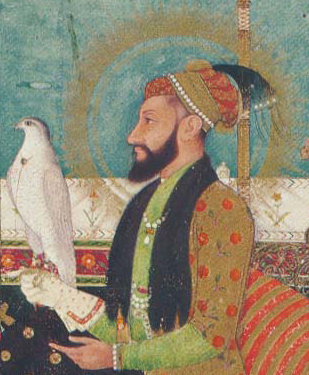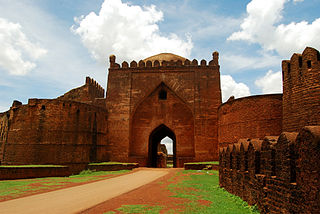
Muhi al-Din Muhammad, commonly known as Aurangzeb, was the sixth Mughal emperor, reigning from 1658 until his death in 1707. His regnal name is Alamgir I, which derived from his title, Abu al-Muzaffar Muhi-ad-Din Muhammad Bahadur Alamgir Aurangzeb Badshah al-Ghazi. Under his emperorship, Mughal India reached its greatest extent and zenith of glory with territory spanning nearly the entirety of the Indian subcontinent.

Mirza Abu'l Fayaz Qutb-ud-Din Mohammad Azam, commonly known as Azam Shah, was briefly the seventh Mughal emperor from 14 March to 20 June 1707. He was the third son of the sixth Mughal emperor Aurangzeb and his chief consort Dilras Banu Begum.
The Deccan sultanates were five late-medieval Indian kingdoms—on the Deccan Plateau between the Krishna River and the Vindhya Range—that were created from the disintegration of the Bahamani Sultanate and ruled by Muslim dynasties: namely Ahmadnagar, Berar, Bidar, Bijapur, and Golconda. The sultanates had become independent during the break-up of the Bahmani Sultanate. The five sultanates owed their existence to the declaration of independence of Ahmadnagar in 1490, followed by Bijapur and Berar in the same year. Golconda became independent in 1518, and Bidar in 1528.

The Adil Shahi or Adilshahi, was a Shia, and later Sunni Muslim, dynasty founded by Yusuf Adil Shah, that ruled the Sultanate of Bijapur, centred on present-day Bijapur district, Karnataka in India, in the Western area of the Deccan region of Southern India from 1489 to 1686. Bijapur had been a province of the Bahmani Sultanate (1347–1518), and member of the Deccan Sultanates, before its political decline in the last quarter of the 15th century and eventual break-up in 1518. The Bijapur Sultanate was fully absorbed into the Mughal Empire on 12 September 1686, after its conquest by the Emperor Aurangzeb.

Abdullah Qutb Shah was the seventh ruler of the kingdom of Golconda in southern India under the Qutb Shahi dynasty. He ruled from 1626 to 1672.

Abul Hasan Qutb Shah, also known as Abul Hasan Tana Shah was the eighth and last ruler of the Qutb Shahi dynasty, sovereign of the Kingdom of Golconda in South India. He ruled from 1672 to 1686. The last Sultan of this Shia Islamic dynasty, Tana Shah is remembered as an inclusive ruler. Instead of appointing only Muslims as ministers, he appointed Brahmin Hindus such as Madanna and Akkanna brothers as ministers in charge of tax collection and exchequer. Towards the end of his reign, one of his Muslim generals defected to the Mughal Empire, who then complained to Aurangzeb about the rising power of the Hindus as ministers in his Golconda Sultanate. Aurangzeb sent a regiment led by his son, who beheaded Tana Shah's Hindu ministers and plundered the Sultanate. In 1687, Aurangzeb ordered an arrest of Tana Shah, who was then imprisoned at the Daulatabad Fort. He died in prison in 1699.
Firishta or Ferešte, full name Muhammad Qasim Hindu Shah Astarabadi, was a Persian historian, who later settled in India and served the Deccan Sultans as their court historian. He was born in 1570 and died in 1620. The name Firishta means 'angel' in Persian.

Yusuf Adil Shah (1450–1510), referred as Adil Khan or Hidalcão by the Portuguese, was the founder of the Adil Shahi dynasty that ruled the Sultanate of Bijapur for nearly two centuries. As the founder of the newly formed Bijapur dynasty, Yusuf Adil Shah is credited with developing the town of Bijapur and elevating it to significant status.
Mallu Adil Shah, of the Adil Shahi dynasty, was the Sultan of the Bijapur Sultanate of modern-day southern India. He ruled for a short period in 1534, before being deposed and blinded.
Ibrahim Adil Shah I was a Sultan and later Shah of the Indian kingdom of Bijapur. He succeeded his elder brother, Mallu Adil Shah, through the machinations of the Afaqi faction at the court. He was the first Adil Shahi ruler to assume the royal title of Shah.

Ali Adil Shah I was the fifth Sultan of Bijapur Sultanate.

Mohammed Adil Shah was the seventh sultan of Bijapur, ascending the throne in 1627. During his reign, he assisted the Mughals with their campaigns against the Ahmednagar Sultanate and signed a peace treaty with them in 1636. He died in 1656 and was buried in the Gol Gumbaz.

Ali Adil Shah II was the 8th Sultan of Bijapur. He succeeded to the throne of Bijapur through the efforts of the Prime Minister Khan Muhammad and the Queen, Badi Sahiba, sister of Qutb Shah of Golkonda on the death of Mohammed Adil Shah, Sultan of Bijapur on 4 November 1656.

The Sultanate of Ahmednagar or the Nizam Shahi Sultanate was a late medieval Indian Muslim kingdom located in the northwestern Deccan, between the sultanates of Gujarat and Bijapur, ruled by the Nizam Shahi or Bahri dynasty. It was established when Malik Ahmed, the Bahmani governor of Junnar after defeating the Bahmani army led by general Jahangir Khan on 28 May 1490 declared independence and established the Nizam Shahi dynasty of the Sultanate of Ahmednagar.

Mir Shihab-ud-Din Siddiqi, known by his title Ghaziuddin Khan, was a leading military general and noble of Central Asian origin in the Mughal Empire. He was a favoured member of emperor Aurangzeb's court, and the father of Chin Qilich Khan, founder of Hyderabad State. Under Aurangzeb, he distinguished himself in key battles over the Deccan, and held the governorship of Berar Subah. He briefly served as the governor of Mughal Gujarat during the reign of Aurangzeb's successor Bahadur Shah, and died in office. He is buried in a madrasa complex he founded during his lifetime, known as Madrasa Ghaziuddin Khan, which is located in Old Delhi.

The Bijapur Fort is located in the Bijapur city in Bijapur District of the Indian state of Karnataka. Bijapur fort has a plethora of historical monuments of architectural importance built during the rule of Adil Shahi dynasty.

The siege of Golconda was a siege of Golconda Fort between the Qutb Shahi dynasty and the Mughal Emperor Aurangzeb, occurring in January 1687, lasting 8 months. The fort was home of the Kollur Mine. The Golconda Fort was considered to be an impregnable fort on the Indian subcontinent. At the end of the siege, Aurangzeb and the Mughals entered Golconda victorious.

The siege of Bijapur began in March 1685 and ended in September 1686 with a Mughal victory. The siege began when Aurangzeb dispatched his son, Muhammad Azam Shah, with a force of nearly 50,000 men to capture Bijapur Fort and defeat Sikandar Adil Shah, the then ruler of Bijapur, who refused to be a vassal of the Mughal Empire. The siege of Bijapur was among the longest military engagements of the Mughals, lasting more than 15 months until Aurangzeb personally arrived to organize a victory.
Shahar Banu Begum was Empress consort of the Mughal Empire from 14 March 1707 to 8 June 1707 as the third wife of Emperor Muhammad Azam Shah. She is popularly known by the titles Padishah Bibi and Padshah Begum.

Deccani architecture, particularly the architecture of the Bahmani and Deccan Sultanates, is the architecture of the Deccan Plateau, and is a regional variant of Indo-Islamic architecture. It was influenced by the styles of the Delhi Sultanate and later Mughal architecture, but sometimes also influenced from Persia and Central Asia. Hindu temple architecture in the same areas had very different styles.















